As we age,
staying connected to our bodies can feel increasingly challenging. For women over 40, this can be especially true when it comes to core strength. You may feel like you’ve tried everything to tone your midsection and improve your stability, yet the results are either minimal or nonexistent. Before you get discouraged, know that you’re not alone. Struggling with core strength is incredibly common, and it has more to do with how we approach movement than age or effort. In fact, many of the reasons core strength feels elusive stem from deeper connections (or disconnections) within the body.
At Move to Nurture Pilates, we support women in midlife who are seeking sustainable, nurturing ways to build core strength without punishing themselves or pushing their bodies past healthy limits. The key lies in understanding how your body functions as a whole and focusing on reconnecting with your body, rather than relying on quick-fix exercises or unrealistic expectations.
In this blog, we’ll explore five reasons why you might be struggling with core strength and how to overcome these obstacles in a way that works for your body.
1. No Connection to Your Pelvis
Your core isn’t just about your abs; it’s about your entire trunk, including your pelvis. Many women are disconnected from their pelvis, which leads to weak core engagement. The pelvis acts as the foundation for your entire core, so if it’s out of alignment or ignored in movement, the rest of your body has to compensate. This can cause strain, misalignment, and even pain in the lower back, hips, and knees.
One reason for this disconnection is our sedentary lifestyles, particularly if we spend hours sitting at a desk or on the couch. Sitting for long periods can lead to tight hip flexors and a lack of mobility in the pelvis. When we then stand up or exercise, our body doesn’t move from its natural alignment. Instead, we brace, overcompensate, or rely on other muscles like the lower back or thighs, further weakening our core.
To reconnect with your pelvis, start by paying attention to how you sit, stand, and move. Small adjustments, like sitting up tall and placing equal weight on your sit bones, can start to build awareness. Pilates exercises that focus on pelvic alignment, such as pelvic tilts, help bring movement and control back to the area, forming the foundation for a strong, balanced core.
2. Immobile Spine
A stiff, immobile spine is another major reason for struggling with core strength. Our spines are meant to move and flex, but many of us carry tightness and stiffness in this area due to stress, poor posture, or lack of movement. An immobile spine not only limits our range of motion, but it also limits how well we can engage our core.
When the spine is tight or out of alignment, the surrounding muscles, including those in the core, can’t contract properly. This leaves us relying on the wrong muscles or bracing (more on that later) in an attempt to stabilize ourselves.
Pilates emphasizes spinal mobility as one of its core principles. By practicing exercises like spinal articulation (rolling the spine bone by bone) and focusing on dynamic movements that flex, extend, and rotate the spine, you can begin to unlock the tension and stiffness. A mobile spine allows for deeper core engagement, as it frees up the muscles around the trunk to work more effectively.
3. Not Using Your Breath
Breath and core strength go hand in hand, but it’s something many of us overlook when working on core stability. The diaphragm, a key muscle in breathing, is also an integral part of your core. When you don’t breathe correctly, your core muscles can’t engage fully.
For example, shallow chest breathing (common under stress) limits the activation of your diaphragm and pelvic floor. These are essential muscles that support your core and help control movement. Without proper breath, you may feel like you’re doing all the right core exercises but not seeing results, because your body isn’t fully utilizing the muscles that help stabilize and strengthen your core.
In Pilates, we teach how to use diaphragmatic breathing to support core engagement. This means breathing deeply into your belly and sides, expanding the rib cage, and exhaling to create a gentle contraction in your core muscles. By syncing your breath with movement, you’ll notice a huge difference in how your core responds during exercises.
4. Bracing Instead of Contracting
One of the most common mistakes people make when trying to build core strength is bracing instead of contracting. Bracing occurs when you tighten your muscles as hard as possible, often holding your breath in the process. This might feel like you’re working your core, but in reality, bracing only leads to tension, shallow engagement, and sometimes even discomfort.
True core contraction is much more subtle and dynamic. Rather than rigidly holding tension, core muscles should be able to contract and release smoothly. Contracting your core should feel like a gentle, firm drawing in of your deep muscles (especially the transverse abdominis) rather than gripping everything tightly.
Pilates teaches proper core activation by focusing on controlled, flowing movements. We often cue clients to “scoop” or “draw in” their abdominals rather than clenching them. This allows the core to stay active and engaged throughout movement without unnecessary strain, helping to build functional strength over time.
5. Expecting Too Much Too Soon
Finally, one of the most overlooked reasons for struggling with core strength is expecting too much too soon. We live in a culture of quick fixes and instant results, but building a strong, functional core takes time, patience, and consistency. Especially for women over 40, the body may respond differently to exercise than it did in younger years. Hormonal changes, past injuries, and lifestyle factors all play a role in how your body builds strength.
It’s easy to become discouraged if you don’t see immediate progress, but expecting rapid transformation often leads to overtraining, frustration, or even injury. Instead, focus on small, incremental improvements. Celebrate when you notice small changes, like feeling more stable during daily activities or having less pain in your lower back. Remember, core strength is not just about aesthetics or achieving a flat stomach—it’s about building stability and mobility for life.
Pilates encourages a balanced approach to core strength. Rather than pushing your body beyond its limits, the emphasis is on gentle progression and mindful movement. This helps you stay consistent with your practice without burning out or getting discouraged.
Sustainable Core Strength at Any Age
Core strength isn’t just for athletes or fitness enthusiasts; it’s a vital part of how we move and function in daily life. For women over 40, reconnecting with your core can be empowering and transformative, but it requires a shift in mindset from “quick fixes” to sustainable, mindful movement.
By addressing these five common barriers—disconnection from the pelvis, spinal immobility, improper breathing, bracing instead of contracting, and unrealistic expectations—you can start to build core strength in a way that supports your body, not punishes it. Pilates offers a holistic approach to core strength that nurtures your entire body, helping you feel stronger, more balanced, and more in tune with yourself as you move through midlife and beyond.
Remember, the journey to core strength is not about perfection or rushing results—it’s about creating a lasting connection with your body that supports you for years to come.
I am working on a FREE online guide to support you to build core strength in a safe and effective way. To get it first, straight to your inbox, sign up in the orange box below. Make it easy on yourself to take the next step. You will hear from me today!





0 Comments